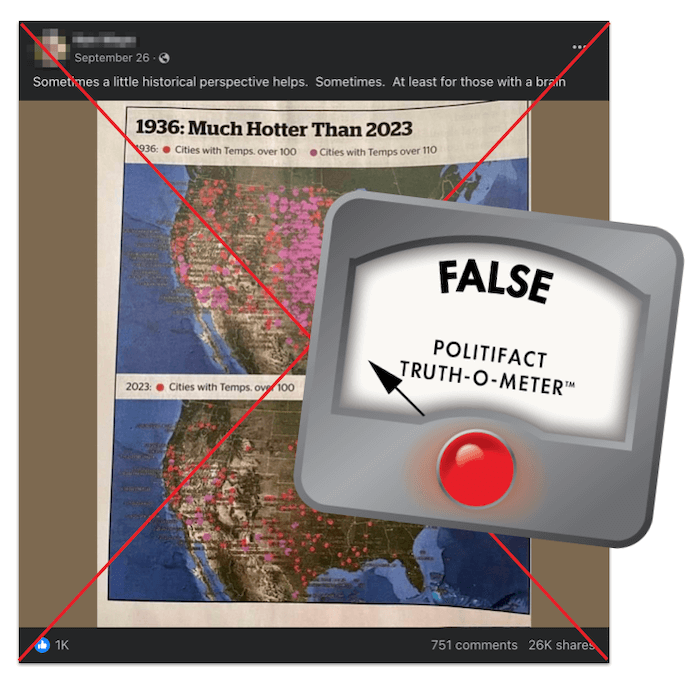In the 1930s, the United States was plagued by extreme heat waves and drought, bringing about the era known as the Dust Bowl. But was that time significantly warmer than today’s climate, as social media posts claim?
A Sept. 26 Facebook post said “1936: Much Hotter Than 2023,” with a photo of two U.S. maps depicting high temperatures across the country in 1936 and 2023.
Red dots on the maps marked cities with temperatures over 100° Fahrenheit and purple dots marked cities with temperatures over 110° F. The 1936 map showed the U.S. covered in red and purple dots, whereas the 2023 map was more sparse, giving the impression that 1936 was the hotter year.

(Screenshot/Facebook)
This post was flagged as part of Meta’s efforts to combat false news and misinformation on its News Feed. (Read more about our partnership with Meta, which owns Facebook and Instagram.)
The post did not name a source for the maps comparing U.S. temperatures in 1936 and 2023, so it is unclear how this data was collected or whether it’s accurate. Our reverse-image searches through Google Images, Yandex and Tineye could not help us determine where the image originated.
Regardless, the post paints a misleading picture of the country’s climate 87 years ago as it compares with today.
Summer 1936 was unusually warm, especially with arid conditions in the Great Plains and Midwest exacerbating the heat. Many of the high temperature records set that year in the region still hold today, the National Weather Service reported.
However, National Oceanic and Atmospheric Administration data shows that in the contiguous U.S., the first nine months of 2023 were 1.64°F warmer than January through September 1936. (An agency spokesperson said October data is still being reviewed.)
Globally, summer 2023 was the hottest on record, NASA reported.
Climate scientists say that the 1930s heat waves in the U.S. are often singled out to rebut the existence of global climate change.
“In climate science, trend is the true indicator of climate change, not a particular cherry-picked year. Recent summers in the United States are some of the worst summers we have on record,” said Randall Cerveny, a geographical sciences professor at Arizona State University.
There’s abundant evidence that the Earth is warming exponentially because of human-caused climate change.
Heat waves, or persistent periods of unusually hot days, are becoming more frequent and intense in the U.S. and other parts of the world. 2023 has already broken several heat records, and climate scientists estimate that it will likely be the hottest on record globally.
We rate the claim that 1936 in the U.S. was “much hotter than 2023” False.
This fact check was originally published by PolitiFact, which is part of the Poynter Institute. See the sources for this fact check here.







